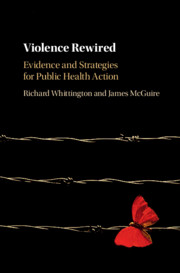Book contents
- Violence Rewired
- Violence Rewired
- Copyright page
- Epigraph
- Contents
- Figures
- Tables
- Boxes
- Foreword
- Acknowledgements
- Introduction and Overview
- Part I Origins
- Part II Solutions
- 6 Advancing a Global Public Health Response to Violence
- 7 Risk Assessment
- 8 Pharmaceutical Interventions
- 9 Psychosocial Interventions
- 10 Changing Structures
- Rewiring Our Expectations
- Appendix Major UN Initiatives to Address Violence, 1986–2018
- References
- Index
9 - Psychosocial Interventions
The Unlearning of Violence
from Part II - Solutions
Published online by Cambridge University Press: 13 March 2020
- Violence Rewired
- Violence Rewired
- Copyright page
- Epigraph
- Contents
- Figures
- Tables
- Boxes
- Foreword
- Acknowledgements
- Introduction and Overview
- Part I Origins
- Part II Solutions
- 6 Advancing a Global Public Health Response to Violence
- 7 Risk Assessment
- 8 Pharmaceutical Interventions
- 9 Psychosocial Interventions
- 10 Changing Structures
- Rewiring Our Expectations
- Appendix Major UN Initiatives to Address Violence, 1986–2018
- References
- Index
Summary
Pharmacology clearly has its limitations and dangers as a tool for reducing violence, especially as part of a public health approach which casts its net so widely across many groups who are viewed as more or less challenging for society. Since it is clear from much of the evidence discussed in Part I of this book that many other factors beyond biology contribute to the tendencies some people have toward violence, it is vital to consider what psychological and social options are available with the potential to counter that tendency. These can be much more expensive to implement because of the need for greater human resources, and, however great the leverage, the intervention can ultimately be refused or ignored. In addition, they are often more difficult to test in terms of efficacy for reasons similar to those discussed in the previous chapter. However, it is psychosocial interventions which the WHO approach endorses most strongly in its ‘best buy’ guidance and which therefore need to be examined here in terms of practicality and effectiveness.
- Type
- Chapter
- Information
- Violence RewiredEvidence and Strategies for Public Health Action, pp. 203 - 224Publisher: Cambridge University PressPrint publication year: 2020



